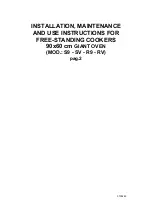
electrolux gas cooktops
LP Gas Conversion 10
Checking the gas supply
1. Check the manometer zero point is correct.
2. Connect the manometer to the cooktop pressure point.
This is located on the regulator.
3. Turn on the gas supply and electricity and try to ignite
the gas.
NOTE! It will take additional time to light the gas for the first
time as air needs to be purged from the pipes.
4. With the appliance operating check the outlet pressure
• when all burners of the appliance are operating at
maximum,
• when the smallest burner of the appliance is
operating at minimum.
Under these conditions the outlet pressure should not
vary from the nominal outlet pressure of 1.00kPa by
more than
±
0.20kPa.
If the regulator appears to not be performing satisfactorily,
then check the following points.
1. If the outlet pressure is consistently too low then the
inlet pressure may be too low and adjustment of an
upstream regulator may be needed, or an upstream
regulator or valve with insufficient flow capacity may
be present in the gas supply line. If this is suspected
then it may be necessary to repeat the checks whilst
measuring both the inlet and outlet pressure to
determine if the inlet pressure is in the range
1.13 – 5kPa.
2. Check that the regulator has been fitted to the gas
supply line in the correct orientation, the arrow on the
base of the body indicates the direction of gas flow.
Once these checks have been completed, if the regulator
still fails to perform in a satisfactory manner it should be
replaced.
Table 3
Burner type
natural Gas (nominal test point pressure: 1.00kPa)
LPG (nominal test point pressure: 2.60kPa)
Injector size (mm)
Gas consumption (MJ/h)
Injector size (mm)
Gas consumption (MJ/h)
Small burner
1.00
5.1
0.55
4.2
Medium burner
1.35
9.0
0.70
6.5
Wok burner
1.80
15.0
1.00
13.2
LP Conversion – Important
This appliance is fitted with natural Gas
burner injectors.
Please follow the procedure below if a conversion to suit
LP gas is required.
The conversion kit contains appropriate LPG injectors and
1 LPG sticker.
1. Remove the hotplate burners to access the hotplate
injectors. Replace the factory fitted NG injectors with the
appropriate injectors, as supplied (see Table 3).
2. Unscrew the hex nut from the regulator. The hex nut,
brass washer and nylon insert will disengage as an
assembly.
3. Unclip the nylon insert and nut assembly by rotating the
insert
¼
turn, and pulling it free.
4. Turn over the insert and clip back into position.
5. Refit the hex nut assembly to the regulator ensuring that
it is fully screwed down. The regulator is now set for
connection to LP.
6. Turn on the gas supply and at each new connection
check for leaks using soapy water: each hotplate valve
should be turned on, one at a time, and the injector
hole blanked off for several seconds.
7. The operation of the regulator can be confirmed by
connecting a manometer to the pressure test point
located on the side of the regulator body adjacent to
the outlet.
With the appliance operating check the outlet pressure
• when all burners of the appliance are operating
at maximum,
• when the smallest burner of the appliance is operating
at minimum.
Under these conditions the outlet pressure should not vary
from the nominal outlet pressure of 2.60kPa by more the
+/-0.52kPa.
8. If the regulator appears to not be performing
satisfactorily then check the following points.
• If the outlet pressure is consistently too low then the
inlet pressure may be too low and adjustment of an
upstream regulator may be needed, or an upstream
regulator or valve with insufficient flow capacity may
be present in the gas supply line. If this is suspected
then it may be necessary to repeat the checks whilst
measuring both the inlet and outlet pressure to
determine if the inlet pressure is in the range
2.75 – 7.00kPa.




































